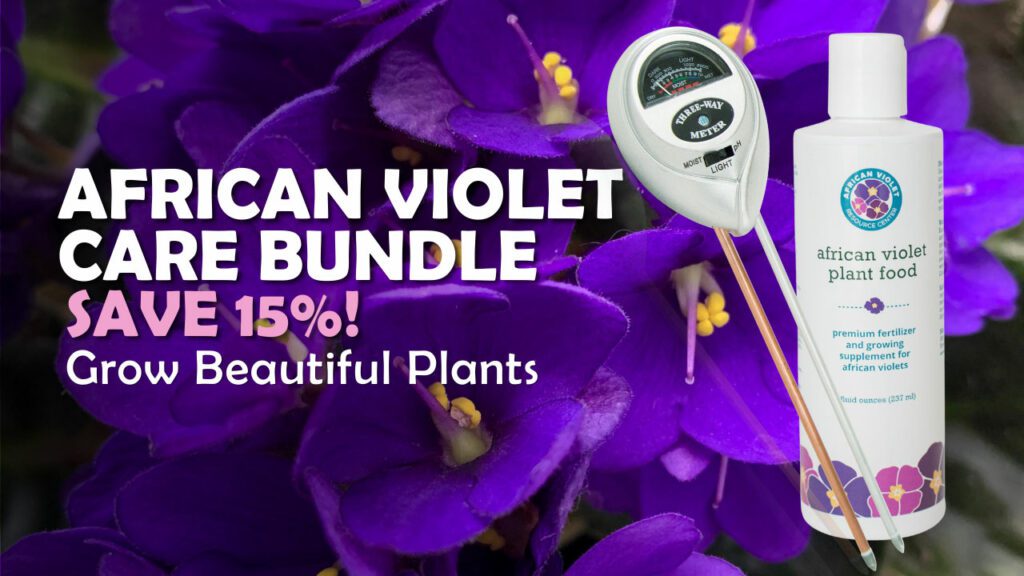African violets are one of the most popular houseplants in the world. However, these lovely little plants have a bit of a reputation for being prima donnas. But here at African Violet Resource Center, we call, “No fair!”
Although African violet care has its quirks, they’re really quite easy to please. Plus, like any good diva, if you’re doing something wrong—they’ll be quick to let you know.
This foolproof guide jumps into what you need to know to please your plant and grow flowers that steal the show!
African Violet Care: The Right Environment
Placing your African violet in the right location is the first step to growing a happy houseplant. Picking the perfect area of your home can be your ticket to glorious year-round blooms. Conversely, picking the wrong area can be your ticket to a host of problems. Let’s take a look at the biggest do’s and don’ts.
Temperature
You might be wondering, “Can African violets be outside?” Unfortunately, the answer is no. African violets are tropical plants and rarely fare well outdoors. Hailing from the Tanzanian jungle, they are highly sensitive to both heat and cold. Because they, like humans, prefer their environment around 70 degrees Fahrenheit, they make awesome indoor companions.
Light
Contrary to popular belief, African violets like the sun. They’re just not fans of excessive heat, and can easily burn under direct sunlight. Also, their leaves can spot if exposed to sunlight while wet, which is one reason bottom watering is popular with this plant.
Find a well-lit area of your home away from the hot, harsh rays of the midday sun. Consider a shelf or table slightly removed from the window so your plant can get indirect sunlight.
Houseplant Pro-Tip: If your plant starts to grow long, spindly leaves, it is literally reaching for more sun. Move that baby a little closer to the light!
Humidity
Like any jungle plant, African violets like it MUGGY. While it’s hard to obtain tropical-like conditions in a typical home, your plant won’t tolerate anything much lower than 50% humidity. If the air is too dry, your plant may withhold its beautiful blooms.
How to Create More Humidity for Your African Violet
- Grouping plants: Placing several African violets near each other can increase humidity substantially. Warning: To prevent infestations spreading and to support airflow, space them far enough apart that their leaves do not touch.
- Humidity tray: Humidity trays, as well as self-watering pots, can help increase humidity because the plants absorb the moisture as the water evaporates.
- Use a humidifier: If your house gets particularly dry during colder months, consider keeping a humidifier near your plants (your stuffy nose will thank you too!).
African Violet Care: Routine Care
Soil Conditions
Soil is your plant’s entire universe. It provides nutrients, captures water, and enables air to reach the roots. Here’s what you need to know about soil conditions and African violet care.
- Potting mix: African violets don’t fare well in conventional potting soil. It’s far too dense for their delicate roots. Instead, opt for a specialty African violet potting soil—or mix your own! Our guide to African violet potting mix will tell you everything you need to know.
- Pot: Encourage blooms by keeping your African violets slightly root-bound. (We promise, they like it!) Look for a pot that is about half the size of the diameter of your plant, or the longest distance from leaf to leaf.
- Fertilizer: Plants need food too! We recommend adding a gentle liquid African violet fertilizer every time you water or refill your plant’s water reservoir.
A note on African violet repotting: While this plant likes it snug, repot once or twice a year to introduce new soil and upsize slightly
Watering
Stand by for an important message about African violet care: These. Plants. Hate. Wet. Leaves!
In nature, the forest canopy protects African violets from the sun. From these conditions evolved a plant with very sensitive leaves. African violets hate cold water on their leaves. They hate it when their wet leaves are exposed to sunlight. In fact, they hate it when you even think about getting water near their leaves.
But don’t sweat it. There are several ways to water your plant without offending its delicate sensibilities. Enter bottom watering, self-watering trays, and moisture wicks. These approaches all involve watering your plant from below and allowing it to self-regulate intake.
Learn more about these African violet watering methods in our helpful beginner’s guide.
African Violet Care: General Upkeep
Just like you, your African violet needs a little regular grooming to look and feel its best. The following tips will help you maintain a healthy, robust plant that can flower all year round.
Leaf Trimming
Even a healthy plant will need occasional leaf trimming. Some sprouts may grow old and die, while others just struggle and should be nipped. Any time you see a leaf starting to decay, trim it away so your plant can redirect that energy toward its beautiful blooms.
Pruning
African violets grow new leaves continuously. To help your plant grow fuller, healthier leaves, prune the bottom three or four once monthly. This makes room for newer, more vigorous replacements.
Houseplant Pro-Tip: Your plant may develop suckers or new offshoots. Both suckers and base leaves can be easily propagated into new plants (for double the fun!).
Pest & Disease Prevention
Unfortunately, African violets are vulnerable to a few common ailments. For both pest and disease prevention, take these following precautions:
- Give them space: Keeping a little distance between potted plants can prevent infections and infestations from spreading. Our advice: Don’t let their leaves touch.
- Keep it breezy: Stuffy and soggy conditions are a breeding ground for pests, disease, and root rot. Plant your African violet in well-aerated soil and place it in an area with good airflow.
- Be a “clean freak”: Always thoroughly clean and inspect new pots and plants before bringing them into your home.
- Spray if you need to: Our Guide to African Violet Problems digs into a few common house pests and how to treat them. If you identify a pest and spray-free treatments are ineffective, a houseplant-friendly spray can finish the job.
What’s your favorite tip for mastering the art of African Violet care? Share your secret weapon in our Facebook group.
Join the African Violet Club!
Whether you’re just starting out or are a seasoned grower, African Violet Resource Center has everything you need to help you master African violet care. Explore our other articles, visit our online shop, and connect with other houseplant lovers in our Facebook group to learn everything you need to know about this rewarding hobby!
More Great African Violet Resources
Stayin’ Alive! A Beginner’s Guide to African Violet Care
Bottoms Up! The Best African Violet Watering Methods for a Happy Houseplant
Making Sense of African Violet Potting Mix (And How to Make it Too!)







